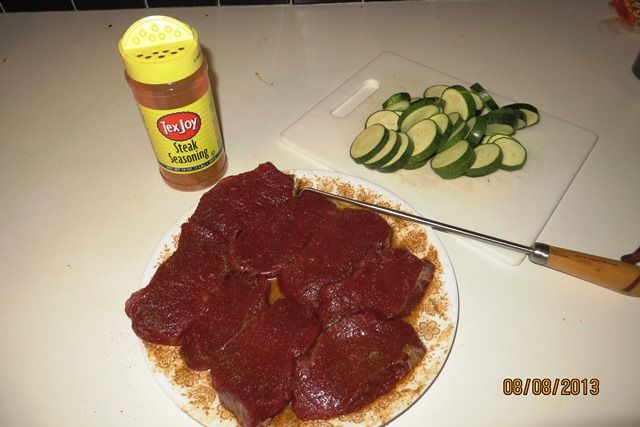Hunt Report: Free Range Oryx
Location: Southern New Mexico
Rifle: Kimber 8400 in .300 WSM shooting 150 grain Barnes TTSX
Other noteworthy gear: Kahles 10x40 bino, Eberlestock X1A1 pack, custom Rainshadow knife
Kalahari Gemsbok (Oryx gazella), commonly referred to as oryx, were released into New Mexico in the early 1970s to provide a big game hunting opportunity in an area of the state (the wide open Chihuahuan Desert) where big game was relatively scarce, primarily due to the lack of water and suitable habitat. Oryx, which were determined to be quite suitable for the region in studies conducted by the NM Game Commission, were originally introduced on the sprawling White Sands Missile Range (WSMR, a US Army base) in southern New Mexico. Game managers expected a huntable population by the year 2000. They seriously underestimated the reproductive capacity of these animals! With excellent habitat and virtually no predators aside from man, these animals thrive in their new environs. They adapted rapidly, and have expanded their range, much to the chagrin of some property owners and our now very xenophobic Department of Game and Fish. Populations have far exceeded the expectations of the original game managers in charge of their release, and now provide a unique hunt for over 1,000 people per year. New Mexico is likely the only place in the US where one can hunt truly free ranging oryx.
With very limited “natural” predation, oryx populations must be managed by hunting. New Mexico oryx hunts are divided into several categories, and all licenses are awarded through an allegedly random drawing. Unlike most other big game species in the state, there is no resident quota on oryx licenses, and non-residents typically draw more than half the available licenses. Within the Missile Range boundaries, specific areas are set aside for once-in-a-lifetime trophy hunts. These are areas that reliably produce trophy animals, year after year. There are also hunts on the Range for broken-horned oryx (BHO), those animals with at least one horn broken off at least 25% and deemed less trophy-worthy. Trophy and BHO hunts are held throughout the year and are only three days in duration. In the fringe areas of the Range, people with WSMR hunt badges (or one escorted by a badge holder) can apply for a license to hunt oryx. These licenses are valid for a given month, during which the hunter may hunt on non-working days in specific areas at WSMR. As I mentioned, oryx populations have expanded significantly in the last several decades, and there are now numerous animals outside of WSMR. Hunts for these animals are conducted in two ways. The first is a population reduction hunt, in which hunters who drew a “spot on the call list” in the random draw are called by the Game and Fish to hunt problem animals at the request of various agencies (USDA, Army, etc.). These hunts are generally arranged on short notice, and if the hunter is unable to participate, he/she loses the opportunity and the next hunter on the list is called. The final major category of oryx hunt in New Mexico is the off-range hunt. Hunters apply for a license to hunt oryx on lands not generally considered to be access-restricted, such as BLM, state trust land, Forest Service, and private land with permission. All other federal govt. agency lands (Army, Air Force, NASA, USDA, etc.) are off limits. Off-range licenses are valid for a full month. Read more about oryx hunting opportunities on the NM Game and Fish page.
In March, I applied for an oryx tag, selecting a BHO hunt as my first choice, an off-range hunt in September as my second choice, and an off-range hunt in August as my third choice. I know it sounds nuts (and it probably is) to want to hunt the southern NM desert in August, but the draw odds for September and August are considerably better than the other months, so that’s what I put in for. A couple months after applying, I learned that I had been drawn for the August off-range hunt!
 Although I’ve accompanied others on a number of hunts over the years, this would be by first time carrying a rifle since 2000, when I drew and filled my once-in-a-lifetime tag. Time flew by, and before I knew it the season was upon me. I didn’t get to scout much on my own, but I had gotten a few good tips from friends who had been successful or seen animals on public land.
Although I’ve accompanied others on a number of hunts over the years, this would be by first time carrying a rifle since 2000, when I drew and filled my once-in-a-lifetime tag. Time flew by, and before I knew it the season was upon me. I didn’t get to scout much on my own, but I had gotten a few good tips from friends who had been successful or seen animals on public land.
One of these fellows volunteered to come along on Friday August 2, the first day I would be able to hunt. We were in position and glassing before the sun rose that morning. After a couple hours of glassing from different vantages, we located a nice bull all alone feeding in a grassy opening. He was a long way off, so we developed a plan to circle around him in the truck, get the wind in our favor, and make an approach. Nice plan, but it failed.
 We apparently circled out too far and couldn’t find him, so we pulled out and found another vantage point about halfway between where we though he was and where we had spotted him from. Bingo! We found him, but not before he had seen us and started edging away. He did stop broadside once at 448 yards, but I wasn’t comfortable with that shot. We watched him trot away. We tried to cut him off, but were hampered by a washed out road and the very thick brush into which he’d disappeared. Rather than push him too hard, we opted to leave him alone and hope that he followed the same feeding pattern the next day.
We apparently circled out too far and couldn’t find him, so we pulled out and found another vantage point about halfway between where we though he was and where we had spotted him from. Bingo! We found him, but not before he had seen us and started edging away. He did stop broadside once at 448 yards, but I wasn’t comfortable with that shot. We watched him trot away. We tried to cut him off, but were hampered by a washed out road and the very thick brush into which he’d disappeared. Rather than push him too hard, we opted to leave him alone and hope that he followed the same feeding pattern the next day.
We spent another couple hours glassing around this location before deciding to pull up stake and head to another piece of BLM land adjacent to WSMR into which oryx sometimes wander (my partner for the day helped a guy kill one here in February). After a little windshield time, we turned off the highway and followed a rocky two-track into some real nice looking country. We found older sign and did a lot of glassing, but were not able to locate any animals. We did come upon an interesting concrete dam that held back a lot of water. The kids couldn’t resist taking some time to play with the tadpoles and a water snake we found there.
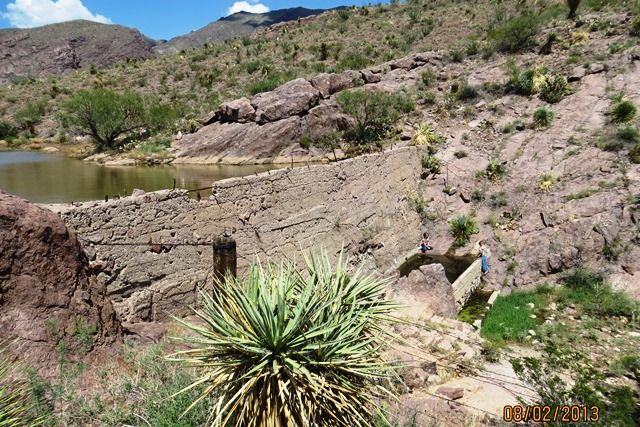
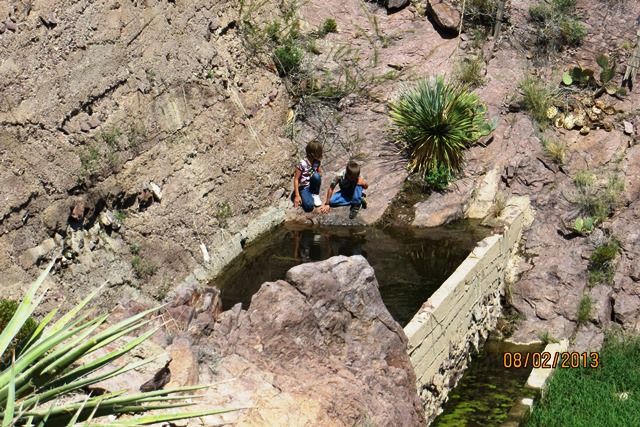
It was getting pretty late in the day, and I was starting to feel my dreaded annual summer cold coming on (perfect timing, right?), so we called it a day.
First thing Saturday morning I went straight back to where we had seen the big bull at 448 yards and started glassing. I spent about an hour behind the binocular but turned up nothing. Time for a relocation. I headed further north into an area with more broken terrain and heavier brush. Within a few minutes glassing from the toolbox, I located two oryx a couple hundred yards from the truck, moving away slowly. They both looked pretty small, but I figured a closer look was in order. I hopped down, grabbed the pack and rifle, and went after them. Unfortunately, the brush was much thicker and taller than it appeared from the truck, and I was unable to get my eyes on them. So after stumbling around aimlessly in the desert for a while ogling all the fresh oryx sign, I figured I’d better just give up and head out. I got back to the truck and circled around to look into the area from another vantage. I was able to spot the oryx again and look them over more closely this time. I determined they were both a bit small and not what I was looking for on the third day of a month-long season. I was starting to feel pretty crappy and knew that I had some chores to take care of, so I called it a day and headed to the house. After a cold medicine-induced nap, I got somewhat productive and canned some peaches and made peach jelly.
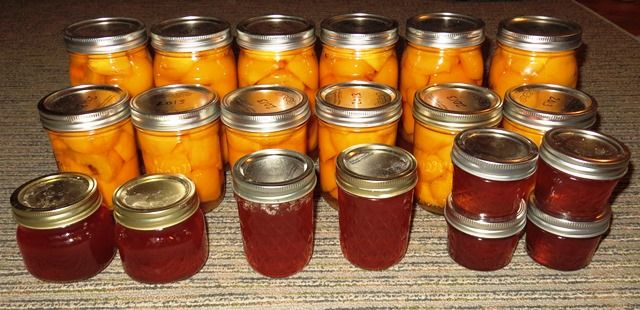
My buddy from Friday was scheduled to come with me on Sunday, but ended up having to stay home to receive an early delivery of hay. I was solo again. However, he offered to come help after stacking hay if I managed to kill one. Still hoping for a shot at the big boy from Friday, I returned to his last known location. No amount of glassing from several elevated vantage points revealed him though. A little bummed, I headed further south. We’d seen some oryx in this area the week before the hunt, but figured they moved even deeper into an area of several square miles with no roads. I drove to the highest piece of ground I could find, climbed up on the toolbox, and started glassing. It wasn’t long before I spotted a small herd of oryx about a mile away in a grassy clearing. It was getting late in the day, and I knew it would be heating up, so I called up a buddy who had hunted this area before and asked for some advice. He directed me to a road on the south end of the area in which the oryx were feeding. I drove about ten miles around them only to find that I was still a mile or more from them! Oh well, at least the wind was better from this side.
I moved gear over from my little day pack into a bigger pack in case I needed to carry meat out, then I started walking. After chugging a bottle of water and a Gatorade, I left the truck at 11:30 am. By 12:30 I’d covered about a mile and a half of desert, crossed three big arroyos, and lost about five pounds of water weight. But I had closed the distance to about 400 yards and confirmed the animals’ location. By this time, the temperature had soared to over 90 degrees, so I knew I would need help if I killed one. I took a few minutes to make some calls and confirm that I still had support. I did, so it was a GO! This is where I made a big mistake. Thinking it would be a quick stalk and shot opportunity, I pulled the rifle from the Eberlestock pack scabbard and ditched the rest. Yes, my pack had all the water in it.
 The oryx were bushed up in a large copse of mesquite bushes/trees. I used some taller brush as cover to get within about 250 yards, but after that all that was left was knee-high scrub creosote. I watched from cover for a while, trying in vain to pick out a good oryx. They were so deep in the brush though that all I could see was a white face here, a flick of the tail there (they have tails like horses, and use them against flying insects in much the same manner), or a glint of horn there. They didn’t seem too inclined to leave the comfort of the only shade for hundreds of yards, so I decided to get closer. I duck-walked and crawled through the creosote brush, with sweat pouring off me and the sun heating my shooting sticks and rifle to near untouchable temperatures.
The oryx were bushed up in a large copse of mesquite bushes/trees. I used some taller brush as cover to get within about 250 yards, but after that all that was left was knee-high scrub creosote. I watched from cover for a while, trying in vain to pick out a good oryx. They were so deep in the brush though that all I could see was a white face here, a flick of the tail there (they have tails like horses, and use them against flying insects in much the same manner), or a glint of horn there. They didn’t seem too inclined to leave the comfort of the only shade for hundreds of yards, so I decided to get closer. I duck-walked and crawled through the creosote brush, with sweat pouring off me and the sun heating my shooting sticks and rifle to near untouchable temperatures.
After about an hour of agonizingly slow forward movement, I had closed the distance to 151 yards. Now it was a standoff. I waited, and waited, and waited for an oryx to leave the shade. Did I mention it was hot? By this time, it was close to if not 100 degrees, and there I was stuck in the open desert with no water. Note to self: don’t leave your water behind, even for a “short” stalk. Anyway, after two hours of intermittently glassing the clump of mesquite and quickly getting on the rifle every time one looked like it was breaking cover, I got lucky. Somewhere a few miles away somebody let loose a string of rapid fire gunfire. Within a couple minutes, thunder boomed from an approaching storm. This combination of noise got the attention of a couple oryx and they wandered out of the thick brush into the more open creosote/grass. I glassed them quickly and determined that one was a small cow and one a decent bull. As they fed out into the open, a couple more began to move, and I noted that one was a pretty nice cow, with longer horns than both of the oryx that came out first. I decided she would be the target if possible.
The first two had different plans though. While the nice cow browsed around in the protection of the relatively thick mesquite thicket, they started feeding right toward me. Recall that I was crouched in knee-high creosote brush. When those two got within about 100 yards of me, the bull figured out I wasn’t an innocent bush and started to get a little nervous. The nice cow was still in the brush, presenting no shot. But with the bull staring me down, I figured the gig was up. I slowly rotated the rifle on my Trigger Sticks until the keen-eyed bull was in the scope. I could tell he was getting real antsy and was afraid he was about to bolt. After an hour-long walk and three hours of crouching, crawling, waiting, and sweating profusely, I wasn’t about to let this end with him thundering off into the desert with all the rest in tow. So, when he turned to leave, he presented a nice broadside shot that I did not refuse. The trigger break was a mild surprise, and the 150 grain Barnes was on its way before I knew it. I heard the solid “thwack” of bullet impacting oryx, and was sure I’d made a good hit. The bull whirled to run straight away, and when he did, all heck broke loose. There were oryx running everywhere, kicking up a huge cloud of dust. I lost sight of the bull I’d shot, so I started scanning for any oryx acting hurt and in need of a second bullet. I didn’t see anything suspicious. As the dust cleared, I was rewarded with the sight of my bull laying in the grass about 30 yards from where he’d been hit.

As I approached the downed bull, the clouds rolled in and rain began to fall. That cool respite didn’t last long though. The sun was back with a vengeance. After I snapped a few pictures…


...I knew I had to get help on the way if there was any hope of saving the meat in that kind of heat. While I returned to fetch my pack (and water!), I called the buddy who’d already offered his help, and another that lives nearby. Against their better judgment, both volunteered to assist with the meat retrieval in the heat, and started heading my way. I broke out the knives and meat bags and went to work. I removed the back straps and the hind quarter, shoulder, and neck meat from one side. I flopped him over to start working on the other side when the heat and three hours without water finally caught up to me. I managed to get the hide laid back from the meat on the other side before taking a break. I was feeling pretty
 from the combined effects of a cold and dehydration, so I laid down in a very small bit of shade for a few minutes. I’d been resting for about five minutes when my phone rang. Help was nearby! I stood up and spotted two assistants just 200 yards away. They headed my way, one of them bringing a badly needed Gatorade. I sucked it down and within a few minutes started to feel human again. With three sets of hands in action, we made quick work of the remaining meat care. We bagged all the meat, strapped it to our packs, and headed out towards the truck.
from the combined effects of a cold and dehydration, so I laid down in a very small bit of shade for a few minutes. I’d been resting for about five minutes when my phone rang. Help was nearby! I stood up and spotted two assistants just 200 yards away. They headed my way, one of them bringing a badly needed Gatorade. I sucked it down and within a few minutes started to feel human again. With three sets of hands in action, we made quick work of the remaining meat care. We bagged all the meat, strapped it to our packs, and headed out towards the truck.
Here’s my new Eberlestock X1A1 loaded up with my gear for the day, the rifle, one quarter of the oryx, and the head and horns, just before tightening all the straps and moving out:
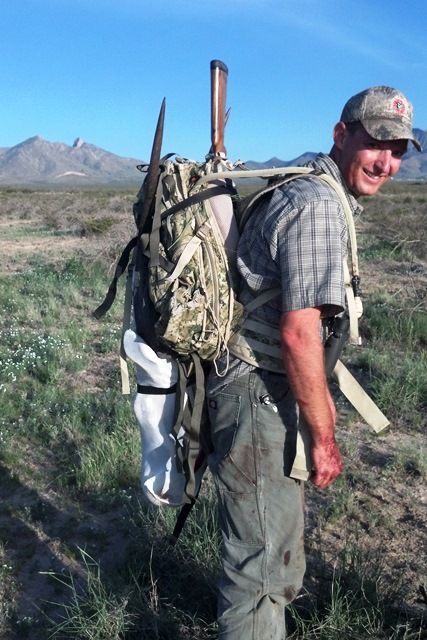
We had to navigate our way back through the maze of deep, steep-sided arroyos. We’d gone about half-way when the third and final helper (the fella that gave me the tip on circling around them) caught up to us and offered a bit of relief. We were about a half-mile from the truck when we encountered a two-track road that our new arrival knew from past experience was the extension of the road on which my truck was parked. We gladly dropped our loaded packs while he headed out to get a truck. About ten minutes later, my phone rang – flat tire (his second of the day). I double-timed it back to the truck to get things moving. We dropped my spare so he could test fit it while I drove back to the other two guys and the meat. We hurriedly removed the meat from the bags and got it in the cooler with ice. We loaded up and drove back out to meet up with the tire killer. Luckily, my spare fit his truck and we were ready. Six hours after pulling the trigger we were on the road to home.
That’s the tale of my free range New Mexico oryx. It was a fun hunt, but I don’t think I’ll readily do it again. Next year I’m putting in for the January off-range hunt!


Location: Southern New Mexico
Rifle: Kimber 8400 in .300 WSM shooting 150 grain Barnes TTSX
Other noteworthy gear: Kahles 10x40 bino, Eberlestock X1A1 pack, custom Rainshadow knife
Kalahari Gemsbok (Oryx gazella), commonly referred to as oryx, were released into New Mexico in the early 1970s to provide a big game hunting opportunity in an area of the state (the wide open Chihuahuan Desert) where big game was relatively scarce, primarily due to the lack of water and suitable habitat. Oryx, which were determined to be quite suitable for the region in studies conducted by the NM Game Commission, were originally introduced on the sprawling White Sands Missile Range (WSMR, a US Army base) in southern New Mexico. Game managers expected a huntable population by the year 2000. They seriously underestimated the reproductive capacity of these animals! With excellent habitat and virtually no predators aside from man, these animals thrive in their new environs. They adapted rapidly, and have expanded their range, much to the chagrin of some property owners and our now very xenophobic Department of Game and Fish. Populations have far exceeded the expectations of the original game managers in charge of their release, and now provide a unique hunt for over 1,000 people per year. New Mexico is likely the only place in the US where one can hunt truly free ranging oryx.
With very limited “natural” predation, oryx populations must be managed by hunting. New Mexico oryx hunts are divided into several categories, and all licenses are awarded through an allegedly random drawing. Unlike most other big game species in the state, there is no resident quota on oryx licenses, and non-residents typically draw more than half the available licenses. Within the Missile Range boundaries, specific areas are set aside for once-in-a-lifetime trophy hunts. These are areas that reliably produce trophy animals, year after year. There are also hunts on the Range for broken-horned oryx (BHO), those animals with at least one horn broken off at least 25% and deemed less trophy-worthy. Trophy and BHO hunts are held throughout the year and are only three days in duration. In the fringe areas of the Range, people with WSMR hunt badges (or one escorted by a badge holder) can apply for a license to hunt oryx. These licenses are valid for a given month, during which the hunter may hunt on non-working days in specific areas at WSMR. As I mentioned, oryx populations have expanded significantly in the last several decades, and there are now numerous animals outside of WSMR. Hunts for these animals are conducted in two ways. The first is a population reduction hunt, in which hunters who drew a “spot on the call list” in the random draw are called by the Game and Fish to hunt problem animals at the request of various agencies (USDA, Army, etc.). These hunts are generally arranged on short notice, and if the hunter is unable to participate, he/she loses the opportunity and the next hunter on the list is called. The final major category of oryx hunt in New Mexico is the off-range hunt. Hunters apply for a license to hunt oryx on lands not generally considered to be access-restricted, such as BLM, state trust land, Forest Service, and private land with permission. All other federal govt. agency lands (Army, Air Force, NASA, USDA, etc.) are off limits. Off-range licenses are valid for a full month. Read more about oryx hunting opportunities on the NM Game and Fish page.
In March, I applied for an oryx tag, selecting a BHO hunt as my first choice, an off-range hunt in September as my second choice, and an off-range hunt in August as my third choice. I know it sounds nuts (and it probably is) to want to hunt the southern NM desert in August, but the draw odds for September and August are considerably better than the other months, so that’s what I put in for. A couple months after applying, I learned that I had been drawn for the August off-range hunt!

One of these fellows volunteered to come along on Friday August 2, the first day I would be able to hunt. We were in position and glassing before the sun rose that morning. After a couple hours of glassing from different vantages, we located a nice bull all alone feeding in a grassy opening. He was a long way off, so we developed a plan to circle around him in the truck, get the wind in our favor, and make an approach. Nice plan, but it failed.

We spent another couple hours glassing around this location before deciding to pull up stake and head to another piece of BLM land adjacent to WSMR into which oryx sometimes wander (my partner for the day helped a guy kill one here in February). After a little windshield time, we turned off the highway and followed a rocky two-track into some real nice looking country. We found older sign and did a lot of glassing, but were not able to locate any animals. We did come upon an interesting concrete dam that held back a lot of water. The kids couldn’t resist taking some time to play with the tadpoles and a water snake we found there.


It was getting pretty late in the day, and I was starting to feel my dreaded annual summer cold coming on (perfect timing, right?), so we called it a day.
First thing Saturday morning I went straight back to where we had seen the big bull at 448 yards and started glassing. I spent about an hour behind the binocular but turned up nothing. Time for a relocation. I headed further north into an area with more broken terrain and heavier brush. Within a few minutes glassing from the toolbox, I located two oryx a couple hundred yards from the truck, moving away slowly. They both looked pretty small, but I figured a closer look was in order. I hopped down, grabbed the pack and rifle, and went after them. Unfortunately, the brush was much thicker and taller than it appeared from the truck, and I was unable to get my eyes on them. So after stumbling around aimlessly in the desert for a while ogling all the fresh oryx sign, I figured I’d better just give up and head out. I got back to the truck and circled around to look into the area from another vantage. I was able to spot the oryx again and look them over more closely this time. I determined they were both a bit small and not what I was looking for on the third day of a month-long season. I was starting to feel pretty crappy and knew that I had some chores to take care of, so I called it a day and headed to the house. After a cold medicine-induced nap, I got somewhat productive and canned some peaches and made peach jelly.

My buddy from Friday was scheduled to come with me on Sunday, but ended up having to stay home to receive an early delivery of hay. I was solo again. However, he offered to come help after stacking hay if I managed to kill one. Still hoping for a shot at the big boy from Friday, I returned to his last known location. No amount of glassing from several elevated vantage points revealed him though. A little bummed, I headed further south. We’d seen some oryx in this area the week before the hunt, but figured they moved even deeper into an area of several square miles with no roads. I drove to the highest piece of ground I could find, climbed up on the toolbox, and started glassing. It wasn’t long before I spotted a small herd of oryx about a mile away in a grassy clearing. It was getting late in the day, and I knew it would be heating up, so I called up a buddy who had hunted this area before and asked for some advice. He directed me to a road on the south end of the area in which the oryx were feeding. I drove about ten miles around them only to find that I was still a mile or more from them! Oh well, at least the wind was better from this side.
I moved gear over from my little day pack into a bigger pack in case I needed to carry meat out, then I started walking. After chugging a bottle of water and a Gatorade, I left the truck at 11:30 am. By 12:30 I’d covered about a mile and a half of desert, crossed three big arroyos, and lost about five pounds of water weight. But I had closed the distance to about 400 yards and confirmed the animals’ location. By this time, the temperature had soared to over 90 degrees, so I knew I would need help if I killed one. I took a few minutes to make some calls and confirm that I still had support. I did, so it was a GO! This is where I made a big mistake. Thinking it would be a quick stalk and shot opportunity, I pulled the rifle from the Eberlestock pack scabbard and ditched the rest. Yes, my pack had all the water in it.

After about an hour of agonizingly slow forward movement, I had closed the distance to 151 yards. Now it was a standoff. I waited, and waited, and waited for an oryx to leave the shade. Did I mention it was hot? By this time, it was close to if not 100 degrees, and there I was stuck in the open desert with no water. Note to self: don’t leave your water behind, even for a “short” stalk. Anyway, after two hours of intermittently glassing the clump of mesquite and quickly getting on the rifle every time one looked like it was breaking cover, I got lucky. Somewhere a few miles away somebody let loose a string of rapid fire gunfire. Within a couple minutes, thunder boomed from an approaching storm. This combination of noise got the attention of a couple oryx and they wandered out of the thick brush into the more open creosote/grass. I glassed them quickly and determined that one was a small cow and one a decent bull. As they fed out into the open, a couple more began to move, and I noted that one was a pretty nice cow, with longer horns than both of the oryx that came out first. I decided she would be the target if possible.
The first two had different plans though. While the nice cow browsed around in the protection of the relatively thick mesquite thicket, they started feeding right toward me. Recall that I was crouched in knee-high creosote brush. When those two got within about 100 yards of me, the bull figured out I wasn’t an innocent bush and started to get a little nervous. The nice cow was still in the brush, presenting no shot. But with the bull staring me down, I figured the gig was up. I slowly rotated the rifle on my Trigger Sticks until the keen-eyed bull was in the scope. I could tell he was getting real antsy and was afraid he was about to bolt. After an hour-long walk and three hours of crouching, crawling, waiting, and sweating profusely, I wasn’t about to let this end with him thundering off into the desert with all the rest in tow. So, when he turned to leave, he presented a nice broadside shot that I did not refuse. The trigger break was a mild surprise, and the 150 grain Barnes was on its way before I knew it. I heard the solid “thwack” of bullet impacting oryx, and was sure I’d made a good hit. The bull whirled to run straight away, and when he did, all heck broke loose. There were oryx running everywhere, kicking up a huge cloud of dust. I lost sight of the bull I’d shot, so I started scanning for any oryx acting hurt and in need of a second bullet. I didn’t see anything suspicious. As the dust cleared, I was rewarded with the sight of my bull laying in the grass about 30 yards from where he’d been hit.

As I approached the downed bull, the clouds rolled in and rain began to fall. That cool respite didn’t last long though. The sun was back with a vengeance. After I snapped a few pictures…


...I knew I had to get help on the way if there was any hope of saving the meat in that kind of heat. While I returned to fetch my pack (and water!), I called the buddy who’d already offered his help, and another that lives nearby. Against their better judgment, both volunteered to assist with the meat retrieval in the heat, and started heading my way. I broke out the knives and meat bags and went to work. I removed the back straps and the hind quarter, shoulder, and neck meat from one side. I flopped him over to start working on the other side when the heat and three hours without water finally caught up to me. I managed to get the hide laid back from the meat on the other side before taking a break. I was feeling pretty

Here’s my new Eberlestock X1A1 loaded up with my gear for the day, the rifle, one quarter of the oryx, and the head and horns, just before tightening all the straps and moving out:

We had to navigate our way back through the maze of deep, steep-sided arroyos. We’d gone about half-way when the third and final helper (the fella that gave me the tip on circling around them) caught up to us and offered a bit of relief. We were about a half-mile from the truck when we encountered a two-track road that our new arrival knew from past experience was the extension of the road on which my truck was parked. We gladly dropped our loaded packs while he headed out to get a truck. About ten minutes later, my phone rang – flat tire (his second of the day). I double-timed it back to the truck to get things moving. We dropped my spare so he could test fit it while I drove back to the other two guys and the meat. We hurriedly removed the meat from the bags and got it in the cooler with ice. We loaded up and drove back out to meet up with the tire killer. Luckily, my spare fit his truck and we were ready. Six hours after pulling the trigger we were on the road to home.
That’s the tale of my free range New Mexico oryx. It was a fun hunt, but I don’t think I’ll readily do it again. Next year I’m putting in for the January off-range hunt!


Last edited by a moderator:




